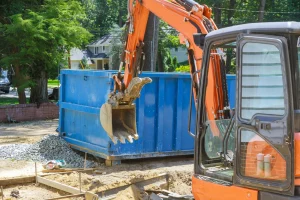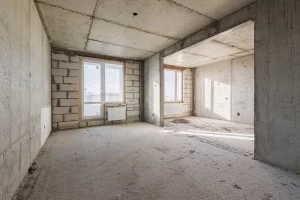Building a woodworking shop can seem like a daunting task, but with thoughtful planning and execution, you can create a functional space tailored to your needs. You will need to plan your layout carefully, ensuring space for essential tools and workstations, while also keeping in mind factors like ventilation and lighting. A roll-off dumpster rental may be necessary, as you’ll generate considerable debris during setup.
Equipping your woodworking shop requires selecting the right tools that match your woodworking ambitions. From a sturdy workbench to power tools like a circular saw, organizing these tools efficiently is key to maximizing your productivity. Consider integrated storage solutions to keep your workspace tidy and avoid clutter.
Safety should never be overlooked in your woodworking shop. Implement effective dust collection systems and make sure your shop layout promotes safe operations. Once your setup is complete, you can embark on exciting woodworking projects with confidence, continually improving both your skills and your shop.
 To efficiently organize your woodworking shop, focus on establishing strategic solutions for tool storage, finding suitable spaces for lumber and plywood, and creating a productive workspace layout. Proper organization ensures safety, accessibility, and workflow optimization.
To efficiently organize your woodworking shop, focus on establishing strategic solutions for tool storage, finding suitable spaces for lumber and plywood, and creating a productive workspace layout. Proper organization ensures safety, accessibility, and workflow optimization.
 Starting woodworking projects can be an exciting endeavor. When approaching these projects, leverage useful resources like plans and videos, and consider the variety of projects you can undertake, from simple items to intricate furniture pieces.
Starting woodworking projects can be an exciting endeavor. When approaching these projects, leverage useful resources like plans and videos, and consider the variety of projects you can undertake, from simple items to intricate furniture pieces.
Key Takeaways
- Careful planning is essential when building a woodworking shop.
- Proper tool selection and organization enhance productivity.
- Safety measures are crucial for a functional and safe workspace.
Planning Your Woodworking Shop
Creating an efficient woodworking shop involves careful consideration of layout, space, electrical needs, and ventilation. Each element plays a crucial role in ensuring a productive and safe workshop environment.Shop Layout and Flow
An efficient woodworking shop layout maximizes workflow by organizing tools and workstations logically. Consider the work triangle—cutting, assembly, sanding, and finishing zones should be arranged in a way that minimizes movement between them. This arrangement not only improves efficiency but also enhances safety by reducing clutter. In a garage shop or larger space, ensure there’s adequate room to maneuver around large projects without obstruction. Make use of mobile workbenches and tool carts to provide flexibility. Allow for easy access to storage space where tools and materials can be kept organized. Thinking about how materials enter and finished projects exit the shop is also beneficial for planning.Location and Space Considerations
Choosing the right location is vital when building a woodworking workshop. A garage or a dedicated shed is often ideal, utilizing natural light to brighten the workspace. If possible, avoid areas with excessive distractions or noise, which can disrupt concentration. Ensure there’s enough space for your most frequently used tools and equipment, like table saws and sanders, to operate safely. Plan for growth, as your tool collection and project sizes may expand. Consider vertical storage solutions to maximize limited space and keep the shop organized. Adequate walking space around all equipment is essential to maintain a safe environment.Electrical and Ventilation Requirements
A robust electrical setup is crucial for handling the demands of power tools. Place electrical outlets approximately 120 cm off the ground to facilitate easy access for machines like saws and drills. Dedicated circuits for heavy-duty equipment can prevent overload and ensure consistent performance. Equally important is a dust collection system and proper ventilation. These systems reduce airborne particles and maintain air quality. Consider installing exhaust fans and air filters to keep the environment clean and safe. Adequate lighting, including task lighting over workstations, can significantly enhance visibility and precision while working.Equipping Your Shop
When setting up your woodworking shop, choosing the right tools is crucial for efficiency and precision. Focus on selecting a combination of power and hand tools to cater to various woodworking tasks.Selecting Essential Power Tools
Picking the right power tools forms the foundation of your woodworking shop. A table saw is often considered one of the most vital stationary power tools due to its versatility in making different cuts. A bandsaw is also important for cutting curves and irregular shapes. For cross-cutting and angle cuts, a miter saw should be on your list. Pay attention to motor size as it affects the performance, especially when dealing with hardwoods. Motor power of at least 1.5 horsepower is recommended for efficient cutting. Investing in quality tools will make your work more precise and safer. Additionally, portable power tools like drills and routers enhance versatility. Drills with adjustable speeds can handle a variety of materials, while routers are excellent for creating decorative edges and intricate joinery. Ensure to choose tools that meet the specific needs of your projects and fit within your budget.Hand Tools and Accessories
The right hand tools are as crucial as power tools. Clamps of various sizes are indispensable for holding pieces in place during assembly and ensuring precision in your work. Always have a variety of measuring tools, such as a tape measure and a combination square, to ensure accuracy in your projects. For smoothing surfaces, a block plane is an essential addition to your toolkit. This tool gives you greater control over surface finish and fit. Keep a set of basic tools like chisels, screwdrivers, and hammers handy. These are essential tools for any workshop, facilitating detailed work and adjustments. Accessories like sandpaper, glue, and fasteners should also be readily available. Organize these items efficiently to ensure quick access during your projects, optimizing your workflow and enhancing productivity. Properly equipping your workspace with these elements prepares you for a wide range of projects in your woodworking journey.Organizing and Storing Tools and Materials
 To efficiently organize your woodworking shop, focus on establishing strategic solutions for tool storage, finding suitable spaces for lumber and plywood, and creating a productive workspace layout. Proper organization ensures safety, accessibility, and workflow optimization.
To efficiently organize your woodworking shop, focus on establishing strategic solutions for tool storage, finding suitable spaces for lumber and plywood, and creating a productive workspace layout. Proper organization ensures safety, accessibility, and workflow optimization.
Tool Storage Solutions
Efficient tool storage in your woodworking shop enhances organization and safety. Pegboards are a practical option, allowing you to hang tools within easy reach. Mobile tool carts add flexibility, enabling you to rearrange your workspace as needed. Consider installing a router table with built-in storage to maximize space. Wall-mounted cabinets are another option, providing enclosed storage to protect tools from dust. Use drawer organizers to separate small items like screws and nails. Integrating these solutions keeps your tools sorted, accessible, and safe, improving your workflow.Lumber and Plywood Storage
Proper lumber and plywood storage protects materials and optimizes your workspace. A sturdy lumber rack is ideal for stacking rough lumber vertically, saving floor space and keeping materials accessible. Utilize wall-mounted brackets for storing plywood sheets flat to prevent warping. Create separate areas for different types and sizes of wood. Shelving systems are useful for categorizing short pieces and offcuts. Ensuring a dedicated space to store wood not only maintains material quality but also streamlines your woodworking process, allowing for easy access and efficient project planning.Creating an Efficient Workspace
Designing an efficient woodworking shop layout is key to enhanced productivity. Start with a central workbench as the focal point, with easy access to essential tools and materials. An adjustable assembly table provides space for intricate tasks and adjustments for different projects. Arrange your power tools to create a natural workflow. Position the dust collector near saws and sanders for easy cleanup. Incorporate mobile tool solutions for flexibility, allowing you to reconfigure the space for various tasks. This seamless setup enhances efficiency and reduces the risk of mishaps, enabling you to focus on your woodworking projects.Dust Collection and Safety Measures When Building a Woodworking Shop
A woodworking shop can generate significant amounts of dust, and implementing effective dust collection systems is essential. Equally important is ensuring safety with the right equipment and preparations.Implementing a Dust Collection System
Establishing a well-planned dust collection system is crucial for maintaining air quality and preventing hazards. Place the dust collector centrally, minimizing duct-run lengths, which improves efficiency. For example, a 3-hp dust collector with optimal bag capacity is suitable for most workshops. Ensure all ducts are well-sealed to maintain airflow consistency, and regularly empty collection bins to avoid overflow and inefficiency. Consider a Shop Vac for small tools or spaces, complementing larger systems. Good ventilation further helps by reducing airborne dust, lowering the risk of respiratory issues.Safety Equipment and First Aid
Safety gear is non-negotiable in a woodworking environment. Equip yourself with a quality dust mask or respirator to protect against inhaling fine particles. Eye protection, such as safety goggles, is crucial to guard against flying debris. Earmuffs or plugs can protect your hearing from loud machinery. Always have a comprehensive first aid kit accessible, covering cuts, abrasions, and inhalation issues. Familiarize yourself with its contents and ensure it’s regularly stocked. Knowledge of basic first aid procedures enhances your ability to respond swiftly to any minor injuries. Keeping a fire extinguisher on hand is also essential, given the fire risk posed by wood dust.Embarking on Woodworking Projects After Building a Woodworking Shop
 Starting woodworking projects can be an exciting endeavor. When approaching these projects, leverage useful resources like plans and videos, and consider the variety of projects you can undertake, from simple items to intricate furniture pieces.
Starting woodworking projects can be an exciting endeavor. When approaching these projects, leverage useful resources like plans and videos, and consider the variety of projects you can undertake, from simple items to intricate furniture pieces.
Using Plans and Videos for Guidance
When embarking on woodworking projects, utilizing woodworking plans is essential. Plans provide step-by-step instructions and measurements, ensuring precision in your work. These can range from simple diagrams to detailed blueprints. Woodworking plans are particularly helpful when constructing complex pieces like a miter saw station, addressing every component involved. Online videos offer a visual guide, allowing you to observe techniques, tool handling, and safety measures. Platforms like YouTube host numerous woodworking videos, where experienced woodworkers demonstrate each step of the process, from selecting the right hardwoods to finishing techniques. By combining plans with these visual aids, you can enhance your understanding and execution of woodworking tasks.Types of Woodworking Projects
Various woodworking projects cater to different skill levels and interests. Beginners might start with simple projects such as picture frames, birdhouses, or shelves. These projects require minimal tools and are a great way to hone basic skills. For those more experienced, constructing pieces such as miter saw stations or complex furniture items presents a challenging yet rewarding experience. Hardwoods are ideal for projects requiring durability and aesthetic appeal, like dining tables or outdoor furniture. Alternatively, softer woods can be used for decorative items or organizational pieces around the home. By selecting the right type of project, you align your woodworking endeavors with your expertise and creativity, ultimately creating items that are both functional and artful.Frequently Asked Questions
Setting up a woodworking shop involves several key considerations, from choosing essential tools to designing an efficient layout. It is equally important to prioritize safety and consider the budget.What are essential tools needed to build a woodworking shop?
Building a woodworking shop requires a few fundamental tools. A quality table saw, miter saw, and a versatile router are among the essentials. You’ll also need clamps, chisels, and a reliable power drill. Consider tools like a belt sander and a planer for finishing touches. Investing in high-quality measuring tools is crucial for precision in your projects.How do you optimize a woodworking shop layout in a confined space?
To optimize a confined space, measure carefully and plan your layout. Position workbenches and major tools like the table saw to allow free movement and airflow. Use vertical spaces efficiently by installing shelving and pegboards. Consider movable storage to maintain flexibility. Ensure workflow efficiency by arranging tools and materials logically.What are some effective strategies for setting up a woodworking shop on a budget?
Begin with essential tools and expand gradually as your budget permits. Purchase second-hand tools where possible, ensuring they meet your quality standards. Prioritize versatile tools that can perform multiple functions. For materials, buy in bulk to save costs, and look for local suppliers or recycled materials for construction needs.What are common mistakes to avoid when designing and building a woodworking workshop?
Avoid neglecting electricity requirements; ensure you have a robust electrical setup to handle tools. Another common mistake is inadequate lighting, which can lead to errors and safety hazards. Overlooking dust collection can contribute to poor air quality. Finally, avoid overcrowding your space; it can hinder workflow and pose safety risks.How can one ensure safety and efficiency when building a woodworking shop?
Safety measures include designing clear pathways and using tools responsibly. Regularly maintain equipment and use personal protective gear, such as goggles and gloves. Ensure adequate ventilation to manage dust and fumes. Efficiency can be achieved by organizing tools for easy access and maintaining a tidy workspace to prevent accidents.Can a woodworking hobby be transformed into a profitable business?
Yes, transforming a woodworking hobby into a profitable business involves planning and dedication. Start by identifying niche markets and unique products that meet demand. Develop a clear business plan covering production, marketing, and sales strategies. Utilize online platforms or local markets to reach customers, and continually refine your craft to enhance product quality and appeal.RECENT BLOGS

Date: March 06, 2025

Date: March 05, 2025

Date: February 26, 2025
Our Reviews
LATEST BLOGS








